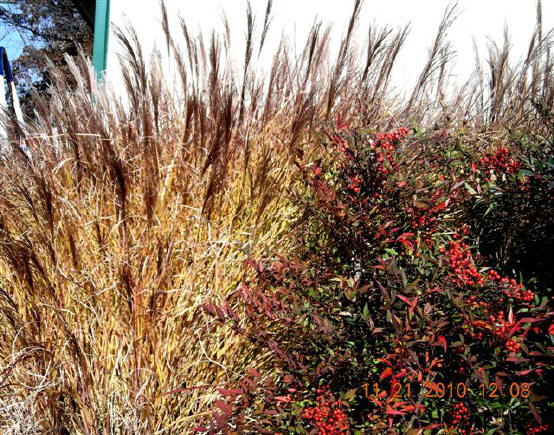|
Don’t Judge Your Fall Garden by its Litter
Martie Young
Adams County Master Gardener
 As I was snipping and cutting and raking and loading all the dried and dead flower stems in my garden I was also thinking of what may be beneficial to leave in the fall garden.
And more important—what "should" be left in the fall garden to winter over. As I was snipping and cutting and raking and loading all the dried and dead flower stems in my garden I was also thinking of what may be beneficial to leave in the fall garden.
And more important—what "should" be left in the fall garden to winter over.
Do you know that many perennial and shrub stems are hollow? These hollow stems provide homes for solitary bees and other insects to find in very early spring. They find their way into the hollow stems (or under some loose tree bark) and lay
their eggs. Soon, as the weather begins to warm up, they will hatch and come out of those stems and begin to pollinate the early spring flowers. Honey bees and bumble bees are generally later than solitary bees (mason bees, orchard bees, and leaf-cutting bees) to begin
pollinating the flowers, especially early blooming fruit trees and brambles.
Some of the perennials and shrubs with hollow stems include coneflowers, agastache, helianthus, helianthemum, sedum, and monarda. Some salvias, the ones with hollow stems, will survive winter better if they aren’t cut back till spring. The
reason to not cut your perennials to the ground is protection from the cold. If there are stems sticking up in your garden, preferably with seed heads still attached, these stems will trap blowing leaves that blanket your garden with warmth. The seed heads provide the added
benefit of food for birds if snow is deep enough to hide the soil. And what could be prettier than viewing a sedum or rudbeckia (black- eyed Susan) with a little crown of snow on top of it right after one of those windless snowfalls?

Miscanthus and Nandina with fall color and red berries
To me it is inconceivable that ornamental grasses are cut back in the fall—sometimes before the seed heads or plumes even form. Ornamental grasses such as Feather reed grass (Calamagrostis ‘Karl Foerster’), Northern sea oats (Chasmanthium
latifolium), Blue oat grass (Helictotrichon sempervirens), and others provide fall and winter color and have the added benefit of providing material for birds building their nests in the spring. Sometimes the leaves have red or blue color that shows up well in your
snow-covered landscape. Just the contrast of the wheat colored leaves and plumes can provide a welcome sight after a snow storm.
Fall is also that busy time of raking and blowing all the leaves from the trees into piles for the municipal leaf sucker to get them. If you have gardens or a compost pile, this is where they should go. You can rake smaller leaves onto your
perennial beds as a protective covering for your plants. The idea here is to keep the soil at a consistent temperature throughout the winter instead of having a bare garden bed that alternately thaws and freezes. The leaves form that insulating blanket. Of course some
leaves are better than others—the Norway maple, sycamore, redbud and some oaks have large flat leaves that form a mat that will smother small, delicate plants. These should be shredded or mowed over with your lawnmower before being used as mulch or a protective blanket.
On the other end of the spectrum, here are some reasons to clear your garden of plant debris: some plants reseed so prolifically that they are more like weeds. The Northern sea oats fits that category. Your compromise may be to cut off some
of the seed heads or to wait until they begin to drop and then clear out those seeds; you still don’t have to cut the plant to the ground-- the seedless stems still serve to protect the roots and the plant from exposure to cold.
Many vegetable garden plants should be cleared so they don’t harbor harmful insects. And your vegetable plants should not be put in your compost if you suspect disease. Tomato plants are particularly harmful in your compost; the same with
vine crops such as cucumber, squash, and melons. The insect or disease may have lived in the plant during the summer and laid eggs that will hatch next spring. The cole crops may be harboring aphids or the ubiquitous white cabbage moth that turns into the green worm that
may greet you as you cook your broccoli.
You may have to add this vegetable garden chore to your fall duties, but remember, all the work of bagging leaves or raking them to the street to be carried away can now be eliminated!
Read other fall related gardening articles
Read other articles by Martie Young |